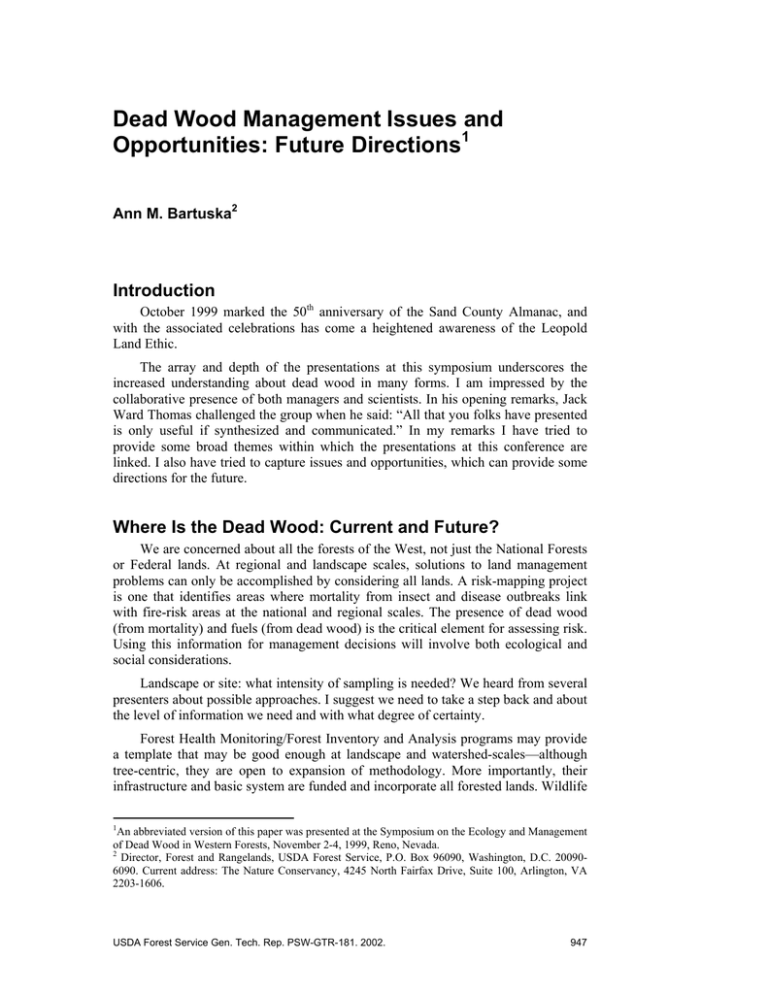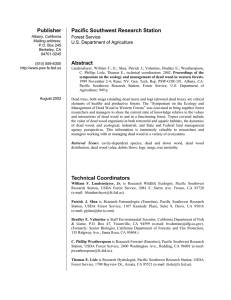Dead Wood Management Issues and Opportunities: Future Directions Introduction
advertisement

Dead Wood Management Issues and Opportunities: Future Directions1 Ann M. Bartuska2 Introduction October 1999 marked the 50th anniversary of the Sand County Almanac, and with the associated celebrations has come a heightened awareness of the Leopold Land Ethic. The array and depth of the presentations at this symposium underscores the increased understanding about dead wood in many forms. I am impressed by the collaborative presence of both managers and scientists. In his opening remarks, Jack Ward Thomas challenged the group when he said: “All that you folks have presented is only useful if synthesized and communicated.” In my remarks I have tried to provide some broad themes within which the presentations at this conference are linked. I also have tried to capture issues and opportunities, which can provide some directions for the future. Where Is the Dead Wood: Current and Future? We are concerned about all the forests of the West, not just the National Forests or Federal lands. At regional and landscape scales, solutions to land management problems can only be accomplished by considering all lands. A risk-mapping project is one that identifies areas where mortality from insect and disease outbreaks link with fire-risk areas at the national and regional scales. The presence of dead wood (from mortality) and fuels (from dead wood) is the critical element for assessing risk. Using this information for management decisions will involve both ecological and social considerations. Landscape or site: what intensity of sampling is needed? We heard from several presenters about possible approaches. I suggest we need to take a step back and about the level of information we need and with what degree of certainty. Forest Health Monitoring/Forest Inventory and Analysis programs may provide a template that may be good enough at landscape and watershed-scales—although tree-centric, they are open to expansion of methodology. More importantly, their infrastructure and basic system are funded and incorporate all forested lands. Wildlife 1 An abbreviated version of this paper was presented at the Symposium on the Ecology and Management of Dead Wood in Western Forests, November 2-4, 1999, Reno, Nevada. 2 Director, Forest and Rangelands, USDA Forest Service, P.O. Box 96090, Washington, D.C. 200906090. Current address: The Nature Conservancy, 4245 North Fairfax Drive, Suite 100, Arlington, VA 2203-1606. USDA Forest Service Gen. Tech. Rep. PSW-GTR-181. 2002. 947 Future Directions—Bartuska biologists are finding this system useful in habitat assessments, and measurements to assess floristic ground-cover are being evaluated. The model development presented in several sessions is really exciting. I was struck that these science-based systems are being designed with managers in mind. We must be smart to ask “at what scale is the model designed to provide information?” What Role Does Dead Wood Play in Ecosystems? The ecosystem arena is where most of the work seems to have been done and where the understanding is the most comprehensive―spanning physical, chemical, and biological processes. The science presented provides a sound foundation for management. Jack Ward Thomas made a strong plea that it is time to integrate and synthesize. This integration must be across disciplines and ecosystems. One speaker was justifiably proud of getting wildlife biologists and fire managers together. I suggest that entomologists, pathologists, and silviculturists also need to be at the table in order for planning to be most effective. Silviculturists, in particular, should become a wildlife biologist’s best friend. Synthesis across ecosystems is overdue. In this way, we can identify the underlying patterns and delineate clear ecosystem-specific patterns. How Do We Manage with Dead Wood? I would suggest what we really need to do is manage with disturbance! As Mark Harmon suggested, we should “manage dynamic systems.” We must learn to manage with uncertainty. Our plans and analyses must recognize that we cannot and will never be 100 percent certain, and in fact, perhaps 50 percent is good enough. As scientists and as managers trained in the academic tradition, we are caught in a “p = 0.01” paradigm. The fact that uncertainty exists in science and in functioning ecosystems should be communicated to policymakers. Can we focus on the structure and assume the other components (fauna, invertebrates, insects, etc.) will fall into place, or do we manage for each of the components separately? This is an issue that both scientists and managers need to address and resolve or we will continue to chase the parts. Missing Pieces The work presented at this conference has addressed the structure, function, and composition of dead wood in the ecosystem. However, ecosystem management identifies three interlocking components: ecological, social, and economic. Both Aldo Leopold and Gifford Pinchot recognized the importance of integrating ecological and social values. The social and economic components of ecosystem management were generally missing. Where are the social scientists? The social values were touched on in some papers. For example, Bob Naimann made the link that woody debris provide a source of insects, which in turn is the basis for recreation fisheries. A landscape with a lot of 948 USDA Forest Service Gen. Tech. Rep. PSW-GTR-181. 2002. Future Directions—Bartuska dead trees visible may not be what the visiting public wants. However, through communications with the public, they may understand and accept widespread mortality caused by natural events. The role of dead wood in the carbon budget, especially carbon sequestration and slow release processes, was incompletely addressed. Hennen’s question about the ecological role of the longevity of standing dead yellow cedar may have its answer in the systems equivalent to long-term carbon storage. There was a surprising absence of references to non-native, invasive species. The current heightened concern about their spread and introduction is touching all aspects of land and water management. One obvious concern is the effect on predicted patterns of mortality from insects and disease. We have good knowledge on the population dynamics of the major forest insects and diseases, and the geographic patterns using the greater than 50 years of annual pest surveys done by the Forest Service and the States. We do not have knowledge of the biology and impacts of recent introductions. Considerations for Future Work Standardization of methods is essential and will be more effective if the scientific and management community does this; otherwise it will come from the top. Scale-specific monitoring systems must be established. Is there such a thing as too much dead wood? Rapid response to disturbance events at all scales should be developed. There are well-established policies and procedures when there are fires, but not with other large-scale disturbances. Synthesis within and across scales is a major gap in our analyses and must be pursued. Are there universal truths or a lot of landscape-specific patterns? Information must be communicated in useful forms to managers and to the public. My closing thoughts echo those of Jack Ward Thomas: we all must assume some responsibility when science is brought to the management table. As scientists, we should continue to strive to better understand the structure, function, and composition of ecosystems. However, when conveying this information to managers, we should ask ourselves questions of practicality and uncertainty. As managers, we must continue to use the best available science, but we can’t be ruled by science. Ultimately, we have to make policy decisions that incorporate other values. Both scientists and managers have a measure of responsibility, and with that, comes accountability. USDA Forest Service Gen. Tech. Rep. PSW-GTR-181. 2002. 949


